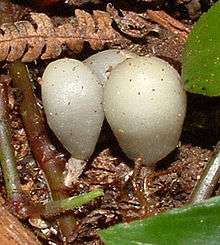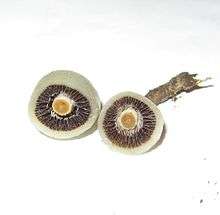Weraroa
Weraroa is a genus of mushrooms in the family Strophariaceae. The genus was initially described by mycologist Rolf Singer in 1958 to accommodate the single species Secotium novae-zelandiae reported by Gordon Herriott Cunningham in 1924.[1] It has been suggested that the genus may represent an intermediary evolutionary stage between a hypogeous (underground) ancestor and the related epigeous (above ground) genus Stropharia.[2][3]
| Weraroa | |
|---|---|
 | |
| Weraroa novae-zelandiae | |
| Scientific classification | |
| Kingdom: | |
| Division: | |
| Class: | |
| Order: | |
| Family: | |
| Genus: | Weraroa |
| Type species | |
| Weraroa novae-zelandiae (G. Cunn.) Singer [as novaezelandiae] | |

Description
Macroscopic
Weraroa species are secotioid fungi, meaning that the margin of the pileus never breaks free of the stipe, making them resemble somewhat a pouch on the end of a stem, or stalked-puffball. The peridium (outer wall), which at maturity is glutinous, may range in shape from fusoid to spherical to ovoid or ellipsoid.
The gleba consists of elongated loculi that are various shades of brown. The stipe may also be glutinous, and is continuous with a columella reaching and merging with the upper peridium, often with a thin veil-like structure that joins the edge of the peridium with the top of the stipe. The context is fleshy and may be gelatinous in the outer portion of the peridium.[4]
Cunningham was first to report that the mushroom takes a long time to mature, and specimens can also persist for long times.[1]
Microscopic
Spores are typically from 10–20 µm in diameter, ellipsoid in shape, smooth, and pigmented ochre to brownish. The basidia (usually 4-spored) often envelop their sterigmata in gastroid-like fashion (i.e., enclosed), and may be narrower in the middle with a broader base. Chrysocystidium are present on the hymenium, on the sterile surfaces of young specimens, and as endocystidia.[4]
Habitat and distribution
Species are usually found in rainforests or wet grasslands, growing on the ground or on wood; species of Weraroa have been found in New Zealand and the United States.
Species
- Weraroa coprophila
- Weraroa nivalis
- Weraroa patagonia
- Weraroa spadicea
- Weraroa virescens
The species formerly known as Weraroa cucculata (Seaver & Shope) and W. erythrocephala (Tul. & C. Tul) Singer & A.H. Sm. (1958) were recently transferred out of this genus into Leratiomyces.[5] This phylogenetic research also demonstrated the close relationship between the type species W. novae-zelandiae to the hallucinogenic blue-staining group of Psilocybe, particularly P. subaeruginosa. Because W. novae-zelandiae is the type species for Weraroa, this information would suggest that the blue-staining Psilocybes should be transferred into this genus. However, the generic name Psilocybe was conserved (Redhead et al. 2007) with the type species Psilocybe semilanceata. Weraroa novae-zelendiae is, therefore, classified as Psilocybe under the new name (nomen novum) Psilocybe weraroa Borovička, Oborník & Noordel. (Borovička et al. 2011).
References
- Cunningham GH. (1924). "A critical revision of the Australian and New Zealand species of the genus Secotium". Proceedings of the Linnean Society of New South Wales 49(2): 97–119.
- Singer R. (1958). "New genera of fungi, IX. The probable ancestor of the Strophariaceae: Weraroa gen. nov". Lloydia 21(1): 45–47.
- Theirs HD. (1984). "The secotioid syndrome". Mycologia 76(1): 1–8.
- Singer R, Smith AH. (1958). "Studies on secotiaceous fungi. III. The genus Weraroa". Bulletin of the Torrey Botanical Club 85(5): 324–334.
- Bridge PD, Spooner BM, Beever RE, Park DC. (2008). "Taxonomy of the fungus commonly known as Stropharia aurantiacea, with new combinations in Leratiomyces". Mycotaxon 103:109–121.
Borovička J., Noordeloos M.E., Gryndler M., Oborník M. (2011): Molecular phylogeny of Psilocybe cyanescens complex in Europe, with reference to the position of the secotioid Weraroa novae-zelandiae. Mycological Progress DOI 10.1007/s11557-010-0684-3.
Redhead S.A., Moncalvo J.M., Vilgalys R., Matheny P.B., Guzmán-Dávalos L., Guzmán G. (2007): Proposal to conserve the name Psilocybe (Basidiomycota) with a conserved type. Taxon 56:255–257.
External links
| Wikimedia Commons has media related to Weraroa. |
| Wikispecies has information related to Weraroa |